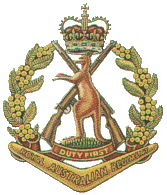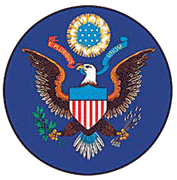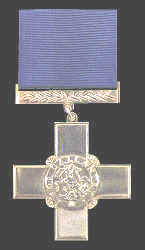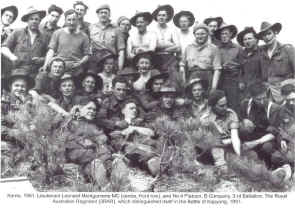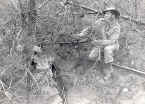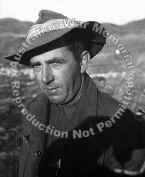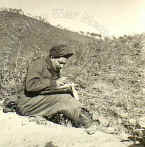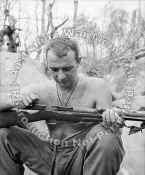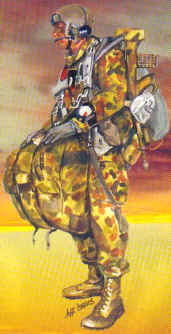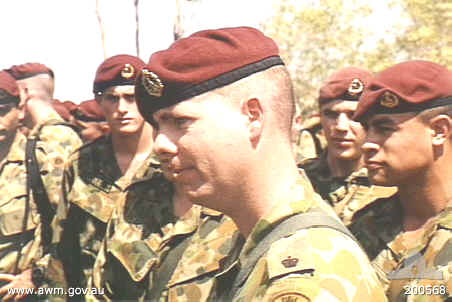 |
|
|
Tours of duty overseas. |
||
| Japan (BCOF) | see below | |
| Korea
As a result of the Battle of Kapyong the Battalion was awarded the US Distinguished Unit Citation |
The Distinguished Unit Citation was redesignated the Presidential Unit Citation (Army) 3 November 1966. |
|
| Malaya | see below | |
| Viet Nam | ||
| East Timor | ||
|
3rd Battalion Royal Australian Regiment in Korea |
| In 1945 Australia sent
three units to Japan as part of the British Commonwealth Occupation
Force (BCOF). Originally known as the 65th, 66th and 67th Infantry
Battalions, they were raised from Australian divisions stationed in New
Guinea at the end of the Second World War. On 23 November 1948, the
battalions were renamed the First, Second and Third Battalion, The
Australian Regiment, respectively. The prefix “Royal” was granted by
King George VI on 31 March 1949.
3RAR was in Japan when it was committed to the US-led United Nations Command forces on 26 July. Volunteers brought the battalion up to its full strength of 960 troops on 11 September, and training was carried out in Japan. On 28 September 1950, 3RAR landed at Pusan, South Korea. The battalion was part of the 27th British Commonwealth Infantry Brigade. Troops from 3RAR were rotated and replaced on an individual basis, and 3RAR remained in Korea for the duration of the conflict. 3RAR was first deployed on 5 October in a counter-attack and advance by the UN Command. 3RAR fought numerous small engagements throughout October, almost on a daily basis. Its first major action was at Yongju (21–22 October) and it advanced through Pakchon (23–26 October) before meeting with heavy opposition at Chongju (29 October). 3RAR’s northern advance ended here. The Chinese launched their First Phase Offensive on 1 November, causing a withdrawal of all UN forces. 3RAR withdrew through the Pakchon area. It blocked an enemy attack on 4–5 November at the Chongchon River. From November to January 1951, 3RAR retreated south. For a brief period it was established north of Uijongbu (12–31 December), before withdrawing through Seoul and regrouping at Chipyong-ni (2-4 January 1951). As part of the withdrawal, 3RAR conducted patrols and destroyed bridges, slowing the Chinese advance. In January 1951 3RAR moved north with the 27th Brigade in a counter-offensive. It engaged the enemy at Chuam-ni (14–17 February), and also secured Hills 614 (24–27 February); 410 (7 March); 703 (12 March); “Sardine” (14 April); and “Salmon” (15 April). This brought 3RAR to the Kapyong Valley, north east of Seoul. On 22 April 3RAR was stationed north of the village of Kapyong on Hill 504. The Australian position was attacked on the morning of 24 April, and the Chinese continued to attack in waves. 3RAR held firm, and on the afternoon of 25 April the exhausted Chinese abandoned their attack. The unit was awarded a Presidential Citation for its role in the battle. On 26 April 3RAR was transferred to the 28th British Commonwealth Brigade. Throughout June and July, the Brigade joined with the 25th Canadian and the 29th British Brigades to form the 1st Commonwealth Division. From April to early August 3RAR conducted patrols that pushed the Chinese northwards. Throughout June it was working to take control of the north bank of the Imjin River. The work was slow and dangerous, with most casualties resulting from mines. 3RAR patrolled the Imjin salient in August and September in preparation for Operation Commando, which began on 3 October. 3RAR’s primary task during this operation was to occupy Hill 317, which it did on 7 October. This action was later known as the Battle of Maryang-San. 3RAR also supported the Fusiliers in the taking of Hill 217, also known as the “Hinge”. From October 1951 until the ceasefire at 11 pm on 27 July 1953, 3RAR’s main activity was patrolling the no man’s land between the two opposing trench lines that ran along the 38th Parallel. 3RAR conducted trench raids, patrols and reconnaissance. Some minor skirmishes resulted in small gains or losses of territory, but overall the front line altered very little in this time. Living conditions were difficult. In winter it was not uncommon for top temperatures to be below zero, and troops had to take precautions against frost-bite and trench foot. At the other extreme, summer was humid, with heavy rain that often flooded the trenches. Added to this were possible attacks from the enemy coupled with shell and mortar fire. Following the armistice, 3RAR was involved in training and border patrols. The battalion returned to Australia in November 1954. Text by AWM
|
|
3rd Battalion Royal Australian Regiment in the Malayan Emergency |
| In 1945 Australia sent three
units to Japan as part of the British Commonwealth Occupation Force
(BCOF). Originally known as the 65th, 66th and 67th Infantry Battalions,
they were raised from Australian divisions stationed in New Guinea at the
end of the Second World War. On 23 November 1948, the battalions were
renamed the First, Second and Third Battalion, The Australian Regiment,
respectively. The prefix “Royal” was granted by King George VI on 31
March 1949.
The Australian battalions sent to the Malayan Emergency formed part of the 28th Commonwealth Infantry Brigade Group (CIBG). CIBG was part of the British Commonwealth Far East Strategic Reserve (FESR). FESR comprised British, Australian, New Zealand and Malayan troops. Australian officers commanded the Australian battalions in Malaya, although operations were part of a larger strategy, requiring co-operation between the FESR units. Efforts were directed against the Communist terrorists. 3RAR arrived in Malaya in September 1957. While in Malaya, the battalion was stationed at Minden Barracks, in the foothills on the eastern side of the island. Although Minden was the nominal home of the battalion while it was in Malaya, it rarely spent any length of time there. Operations through the jungle lasted for days or even weeks at a time, and breaks between operations were brief. During its service in Malaya, the battalion operated with three rifle companies, instead of the usual four. The battalion trained at Kota Tinggi throughout October and November. It began operations on 1 December, joining Operation Shark North. Shark North was a search and security mission that aimed to destroy the communist influence in the Kuala Kangsar and Upper Perak districts. The operation had begun in May 1956. In January 1958, the battalion joined Operation Ginger. Ginger aimed to disrupt food supply by searching the areas between terrorist bases and food stores. Ginger was waged across an estimated area of 3,100 square kilometers, searching for approximately 170 terrorists and 24 hostile native inhabitants. The majority of the work involved tracking, searches and setting ambushes. It was monotonous and frustrating work that rarely yielded measurable results. It was not uncommon for rain to wipe out tracks that had been followed for over a week, or for the terrorists to cross the Thai border, where the battalion was unable to pursue them. Operation Ginger was ultimately a success, and when it ended on 21 April 1959, Perak was declared a safe area. In addition to participation in anti-terrorist operations, the battalion took part in “major war training” throughout March–September. 3RAR was withdrawn from operations on 12 September, departing for Australia on 5 October. Casualties; 4 killed, 14 woundedDecorations 2 MBE and 10 MID |
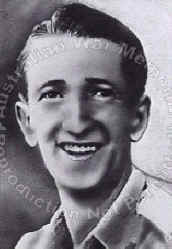 |
Private Horace William Madden GC, 3 RAR who was posthumously awarded the George Cross for outstanding heroism while a prisoner of war of Chinese communist forces in Korea from 1951-04-24 until about 1951-11-06, when he died of malnutrition and the result of ill treatment. |
|
| He resisted all enemy efforts to force him to collaborate, to such a degree that his name and example were widely known through the various groups of prisoners. Despite repeated beatings and many other forms of ill-treatment inflicted because of his defiance to his captors, Madden remained cheerful and optimistic, and was known to share his meagre supplies of food with other prisoners who were sick. |
| This flag was raised by signallers of Company Headquarters, 'C' Company, 3 RAR, on Hill 323 in the Long Hai Hills, Vietnam, during Operation Pinnaroo on 19 March, 1968. The company had been warned for a move up the hill by foot through suspected minefields to secure a landing zone for the insertion of 'A' Company. The flag was carried up the hill by the signallers and raised on top of a high rock at the top of Hill 323. A note of interest is that shortly after the raising the flag, battalion headquarters received a request for ground clearance from a US warship lying off shore to enable them to shoot at a 'VC flag which has just been raised'. |
|
|
| Palmerston, NT. 20 September 1999. Major Hermann (centre) and Lieutenant Kiwi (right), both of the 3rd Battalion (Parachute), The Royal Australian Regiment (3RAR) in the Robertson Barracks coumpound. The Prime Minister, John Howard, accompanied by other politicians travelled to Darwin to bid farewell to the troops prior to their departure to join the International Force for East Timor (Interfet). |
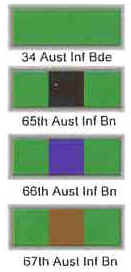 |
A BRIEF HISTORY OF 3 RAR Formation of 3 RAR The force, designated the 34th Australian Infantry Brigade, comprising 65th, 66th, and 67th Battalions was assembled at the island of Morotai in the North Moluccas. 67th Battalion was formed on 20 October 1945 consisting of volunteers from the 3rd, 6th, 7th and 11th Australian Divisions located in the New Guinea mainland and in Bougainville, the Solomon Islands and New Britain.
|
 |
Shoulder flash of the 67th Australian Infantry Battalion (later to become 3AR then 3RAR) |
Japan 1946 - 1950 The main body of 67th Aust Inf Bn arrived at Kure, Japan on 21 Feb 46 and throughout its time in Japan, the Battalion served at Kahachi, Okayama, Haramuri, Kure, Hiro and Tokyo. The Battalion's tasks during this
period included the screening of returning Japanese soldiers, the
destruction of arms caches, the supervision of general elections, guard
duties on various important buildings and installations, anti-piracy,
the suppression of race riots, as well as normal military operations. On 23 Nov 48, 67th Battalion was
redesignated the 3rd Battalion, The Australian Regiment. On 10 Mar
49 the prefix "Royal" was appended to the title "The
Australian Regiment." Korea up to Kapyong With the surrender of Germany signalling the final phases of the Second World War, the British and Australian governments held talks on the part the two countries would play in the invasion of the Japanese home islands. The British Prime Minister enquired if an Australian Division could be made available. As peace came sooner than expected, the invasion force was not required and the problem of Commonwealth participation in the occupation force then arose. On 1 October 1945 agreement was reached and it was decided the Australian component would consist of two cruisers, three fighter squadrons and an infantry brigade. This Brigade, a volunteer force designated 34th Australian Infantry Brigade, consisted of the 65th, 66th and 67th Infantry Battalions, was raised and assembled at Morotai. 67th Battalion was composed of elements of the 5th, 6th, 7th and 11th Australian Divisions located at that time in the New Guinea area. As part of the British Commonwealth Occupation Force Japan, the main component of 67th Battalion landed at Kure on 21 February 1946. The battalion's role during it's time in Japan ranged from processing repatriated Japanese soldiers and prisoners of war, guard duties on public buildings to the suppression of riots. On 23 November 1948, 67th Battalion was renamed Third Battalion, The Australian Regiment. On 31 March 1949, His Majesty King George VI granted the prefix "Royal" to the Regiment. On 25 June 1950, as 3rd Battalion stationed at Hiro was preparing to return to Australia, news was received that the North Koreans had crossed the 38th parallel and were driving towards Seoul, the capital of the Republic of Korea. As part of military aid offered by Australia to the United Nations for service in Korea, 3rd Battalion underwent ten weeks intensive training at the former Imperial Japanese Army jungle training centre at Haramura, 40 kilometres from Kure, and on 27 September 1950 the Battalion augmented by two drafts from Australia and 960 strong, embarked in USNS "AIKEN VICTORY" at Tokyo. Landing at Pusan the following day, the Australians joined 27th Commonwealth Brigade at Taegu. Five days later the Battalion suffered its first casualties, when Capt K Hummerston and Pte K Sketchley were killed near Waegwon. After their first action at Waegwon on October 1, the battalion moved by air to K16 Airfield at Kimpo near Seoul and prepared for further active service. On 5 October 50 the battalion deployed to take part in the 8th Army Offensive. During the ensuing advance to the Yalu River, 3RAR performed with great credit, covering some 400 miles and accounting for approximately 450 enemy killed, 1,982 prisoners taken and 15 armoured vehicles destroyed. This was the largest single capture of enemy troops during the entire war. The battalion's casualties were 13 killed and 34 wounded. The battalion moved purposefully northwards. On 23 October, the Chongchon River was crossed and Pakchon taken, together with 225 prisoners. After crossing the Taeryong River, Chongju near the west coast and just 64 kilometres from the Yalu River and the Manchurian border was the next objective. On the 29th, the battalion relieved the 187 American Airborne Regimental Combat Team, which had been surrounded by a North Korean Regiment. This action became known as the Battle of the Apple Orchard. After strong resistance by North Korean infantry supported by T34 tanks, Chongju was entered on 30 October 1950. At dusk the same day a shell fragment wounded Lieutenant Colonel C. H. Green the Battalion Commander. Taken to hospital at Anju, he died two days later on 1 November. For a time the battalion was under the command of Lieutenant Colonel F S Walsh. However, a short time later, Lieutenant Colonel Ian Ferguson MC MID was given command of the battalion. At Chongju the Australians suffered casualties of 9 killed and 30 wounded. It was on this day that the Communist Chinese Forces entered the war. On 31 October, the battalion was moved to Pakchon where they relieved the Argyll and Sutherland Highlanders who had earlier taken these hills but had been driven off. The RAAF, 77 Squadron supported the battalion with air strikes on enemy held hills. This was the first time, 77 Squadron had provided air support to the battalion. The following day 5th and 8th Cavalry Regiments of the 1st United States Cavalry Division were engaged by Chinese forces. On 27 November, 3 RAR was moved to Kunu ri where they met up with the Turkish Brigade for the first time. But the Chinese were pressing hard on their heels. The 27th Brigade fell back to Sunchon, and by the first week in December, the United Nations' forces were in general withdrawal, mostly on foot. The North Korean capital of Pyongyang was abandoned on 4th December, and by the 11th the Australians were in reserve at Uijongbu, 24 kilometers north of the capital, Seoul. During November and December 1950 the Chinese gathered for another thrust against the United Nations troops with 3 RAR holding roads and river crossings as the UN forces were pushed back. From 1st January 1951, the battalion held the Chinese advance to cover the withdrawal of 27 Brigade. The Australians withdrew across the Han River and by the 4th, Seoul had been abandoned to the advancing Chinese. At Chuam ni, between 13 and 15 February, a US Armoured Reconnaissance Patrol became ambushed. When the troops of 3 RAR and the Middlesex Regiment came upon the scene, they saw only dead bodies and the abandoned jeeps and tanks. About 60 US servicemen lost their lives that day. Through the end of February and early March 1951 bitter fighting continued. Conditions were awful the middle of the harsh Korean winter with lots of snow. The fighting continued on steep and narrow ice capped ridges, given the names according to their height in metres 614, 410, 532 and then 703. The wounded were forced to slide down the snow covered hills. The battle honour, Maehwa San, covers the taking of all these objectives. But the fighting had taken its toll on the Chinese also. No one will ever know the extent of their losses. Once it became clear that the enemy were withdrawing, Seoul was re entered on 14 March 1951. The Australians went into reserve where they remained until 25th March. In the next few weeks the battalion took part in the advance in force towards the 38th parallel. With the support of New Zealand artillery, hills, codenamed "Sardine" and "Salmon", north of Karim, were captured. By that time the battalion had suffered 55 killed in Action, 205 Wounded in Action and 5 had been taken Prisoner of War. Someone took note of the hard fighting and the many actions the battalion had taken part in, and decided to place the battalion behind the lines in reserve. On 19th April, 27th Brigade withdrew 48 kilometres to the southeast into corps reserve near the village of Charidae, a few kilometres north-west of Kapyong. Plans were made to celebrate Anzac Day with the New Zealanders and the Turks. The battalion was resting with a full Republic of Korea Division between it and the enemy. A good rest looked assured. But it was not to be.
On the night of 22 Apr 51, the Chinese launched their Spring offensive and the 6th ROK Division withdrew in disorder through the battalion's position. On the 23rd April 1951, the 27th Brigade was ordered north to Chuktun ni, 11 kilometres to the north of Charidae, where they were deployed to defend the Kapyong Valley. That evening, the main Chinese force reached the battalion's perimeter. During the 23 and 24 Apr 51, in the face of continuing attacks, the battalion held its position, exhausting and demoralising the Chinese and gradually blunting the offensive. 3 RAR were positioned with A, C and D Companies on high ground to the east of Chuktun ni, and B Company positioned on the left flank on a long scrub covered rise between the road and small stream. The battalion was to cover the ford across the river and to guard the road from the northeast. The Middlesex were to occupy high ground to left of the road on the slopes near Sudok San. However, when news of the Chinese offensive was received, they were sent forward to provide infantry support to the New Zealand gunners, and as a result, the Middlesex never occupied this position. When they returned with the gunners after the retreat of the ROK division, both gunners and Middlesex took up a position some six kilometres to the rear of 3 RAR. The 2nd Battalion Princess Patricia's Canadian Light Infantry were positioned around Hill 677 to the left rear of 3 RAR. 3 RAR's orders were that we were there overnight as a precautionary measure. The battalion expected to return to corps reserve the next morning. But the Australians were 50 kilometres behind the front line so felt relatively secure. However, as darkness fell on the 23rd, the retreating South Korean troops began to flood back through the 3 RAR position, knocking out telephone lines and masking the advance of the Chinese, who then proceeded to attack the rifle companies, battalion headquarters and support company units. Radio communications between HQ and the rifle companies from then on became a serious problem. Only B Company could be contacted directly. Later in the night, the CO moved to the Middlesex position in an effort to improve radio communication, and thus achieve better control of the action. The fighting escalated and all through the night the Chinese attacked again and again. Each time they were repulsed they regrouped, and attacked again. Their casualties were horrendous, but wave after wave of Chinese were thrown into the battle over the bodies to their dead companions. The fighting went on all through the day of the 24th. Our troops were weary and hungry. Their last meal had been a hot meal on the evening of the 23rd, and nothing could be brought forward to them as the enemy had established a roadblock. The battalion headquarters and RAP had withdrawn to the area occupied by the Middlesex battalion, six kilometres to the rear, in the early hours of the 24th. The Mortar Platoon, Anti Tank Platoon and Assault Pioneer Platoon withdrew at first light. The rifle companies remained in position and command of these passed to the senior rifle company commander, Maj Ben O'Dowd. Relief of the battalion, by a US Regimental Combat Team, had been promised. However, in the afternoon advice was received that no support would be forthcoming. It was clear that the battalion could not remain in its present position due to the shortage of ammunition and the number of casualties that have been suffered. Maj O'Dowd was faced with the task of withdrawing the remaining troops. It was obvious that the withdrawal could not be made by road as the Chinese were in possession of that area. After B Company was ordered to clear the ridge line from Hill 504 down to the ford in the vicinity of the Princess Pat's. The rifle companies were then withdrawn by leapfrogging each company along the ridgeline with covering fire provided by the Kiwi artillery gunners. By 2300 hours, the battalion had been successfully withdrawn. The battalion had suffered 33 dead, 59 wounded and 3 were taken prisoner. For its fine display of courage and steadfastness the battalion was awarded the United States Presidential Citation.
Kapyong to the Cease Fire
In Operation Commando in Oct 51, the battalion assisted in the capture of Point 355 and played a leading part in the capture of Maryang San (Point 317). In five days of heavy fighting 3RAR dislodged a numerically superior enemy from a position of great strength. This classic offensive action is acknowledged as an RAR battle honour. In the period from Nov 51 to the Armistice, 3RAR occupied various positions in Jamestown Line between 'The Hook' and Point 355 with brief periods in brigade and corps reserve. The role of the unit, like that of all UN forces, became one of defence; the holding of a strong defence line extending across Korea just north of the 38th Parallel. During this period, 3RAR became known for the aggressive spirit displayed by its patrols and the procedures evolved by it were accepted as the basis of the Division's policy for the organisation and control of patrols. At the cessation of hostilities on 27 Jul 53, the battalion was occupying Point 146. On 3 Aug 53, it moved from there to its post hostilities location at Area 6, on the Jamestown Line. During the Korean War, 3RAR casualties were 198 killed, 892 wounded and 38 missing in action. Perhaps because the Battalion was the first Australian Army unit in action in Korea and was still in the front line when the fighting stopped, it became as "Old Faithful" among other units serving there and is still referred to affectionately as such today.
Despite the ceasefire, 3RAR remained in Korea for another 14 months improving its defensive position on the Kansas Line and conducting unit and sub-unit training. From it's foundation nine years earlier, the Battalion had never served in Australia, but on 12 October 1954 at Pusan, 3RAR embarked in the "New Australia" and sailed for home. On October 20 "Old Faithful" arrived in Brisbane. During it's deployment in Korea, 3rd Battalion, The Royal Australian Regiment suffered total casualties of 198 killed, 892 wounded and 38 missing in action. Living up to their regimental motto, they put "Duty First" and set a record second to none and one of which they could be justifiably, proud. They showed quite clearly they could maintain the high standards expected of, and given by, the Australian serviceman. ACTIVITIES BETWEEN KOREA AND VIETNAM Australia 1954 - 1957 The Battalion arrived in Brisbane on
20 Oct 54 and paraded through the city. This was followed by similar
parades through Sydney and Melbourne. Finally, the unit concentrated at
Ingleburn on 1 Feb 55. On Kapyong Day 1956 3RAR received the Queen's and Regimental Colours from the Governor General, Field Marshall Sir William Slim, GCB, GCMG, GCVO, GBE, DSO, MC, KStJ. From Ingleburn the Battalion moved to
Holsworthy to undergo three months of intensive training in preparation
for its deployment to Malaya and with this training completed embarked
on the 'New Australia' in Sydney on 24 Sep 57. Malaya 1957 - 1959 The Battalion arrived in Singapore on
11 Oct 57 and had a period of acclimatisation at the FARELF Training
Centre Kota Tingi (later to become the Jungle Warfare School).3RAR then
moved to company base camps at Kuala Kangsar (BHQ), Lasah, Sungei, Siput,
Penang and Lintang. The unit was engaged on anti-communist
terrorist operations in northern Malaya. Operations began in Nov 57 and
as a result many terrorist camps and food dumps were located and
destroyed.3RAR was accredited with killing 14 terrorists and was
responsible for the capture of 32 others.Battalion casualties over the
two years was one KIA, two WIA and two died of illness. Australia 1959 - 1963
Malaya and Borneo 1963 - 1965 The second tour of Malaya began on Jul
63 and 3RAR again joined 28 Commonwealth Infantry Brigade, this time at
Terendak near Malacca.Training for anti-terrorist operations began
immediately and the Battalion was honoured to serve for the first time
with the Scots Guards, its affiliated British Regiment. The Battalion moved to the
Thailand-Malaya border on 20 Feb 64 and was successful in uncovering
many old and new terrorist camps and in apprehending illegal immigrants
and smugglers. In late Oct 64, an aggressive force of
Indonesian troops landed at Kesang slightly south of Camp Terendak.The
unit was alerted and a force went into action capturing more than 50
enemy without loss to the Battalion. During Mar 65, a serious threat
developed in the Borneo states and the unit was once again alerted and
on this occasion deployed in the state of Sarawak relatively close to
the capital Kuching. This operation lasted some five months with the
unit returning to Terendak at the end of July.The unit acquitted itself
very well on this tour killing approximately 30 enemy troops for the
loss of three of our own troops and an Iban tracker. Australia 1965 - 1967
3RAR's advance party arrived in Saigon
on 12 Dec 67.The main body followed on HMAS Sydney departing from Outer
Harbour, Adelaide on 16 Dec 67. VIETNAM Vietnam 1967 - 1968
Subsequent operations were undertaken
in and out of Phuoc Tuy province with the Battalion employed on mine
clearing, counter mortar and rocket tasks and on numerous
reconnaissance-in-force operations.During 26 and 28 May 68, 3RAR, while
in a battalion defensive position, withstood two determined assaults by
regimental sized units of the North Vietnamese Army at FSPB
"Balmoral". While in Vietnam, 3RAR once again
formed many close ties with supporting arms and services and the
RAAF.The Battalion was proud to be associated with 161 Fd Bty, RNZA, a
105mm Howitzer battery of the 16 Fd Regt RNZA which supported 3RAR
during the Battle of Kapyong. Australia 1968 - 1971
Vietnam 1971
On 6-7 Jun in southern Long Khanh
Province, the Battalion located and attacked an extensive bunker complex
occupied by 3rd Battalion, 33rd North Vietnamese Regiment. After a long
battle involving artillery, armour, Australian and United States
helicopter gunships, the system was found to contain 47 bunkers as well
as training areas and kitchens. In August, the Prime Minister of
Australia announced the withdrawal of 1ATF combat troops. Following a
commemorative service and farewell parade on 5 Oct 71, 3RAR sailed for
Port Adelaide, South Australia on 6 Oct 71.During this tour four 3RAR
soldiers were killed in action. POST VIETNAM 1971 - 1999
Early in 1982, the Battalion was
instructed to begin training for airborne operations and soldiers
immediately began attending courses at the Parachute Training School,
Williamtown. By mid 1983, the Battalion was able to conduct
company sized parachute operations and on 21 Oct 83, 3RAR became the
Parachute Infantry Battalion of the Royal Australian Regiment and became
the core of the Parachute Battalion Group, the ADF's conventional
parachute force. EAST TIMOR Operation Spitfire At 0730 hours on Friday, 27 August 1999 the soldiers of Bravo Company, 3 RAR, were ordered to parade in front of their headquarters building in Kapyong Lines at Holsworthy Barracks, Sydney. They were promptly and curtly told that the Company was to immediately deploy to a destination unknown on a mission that was yet to be announced. It was the first time that 3 RAR soldiers had an inkling of their involvement in OPERATION SPITFIRE. Bravo Company was the 3 RAR PBG on line rifle Company and as such was expected to be operationally deployable within a notice of forty eight hours should the need arise. This notice to move was not adhered to by necessity. B Company drove out of the Battalion gates at 1500 hours on 27 August. Forty-eight hours had been reduced to seven and a half. For the first time since South Vietnam the soldiers of `Old Faithful' were embarked on active service. That fateful Friday was a surreal day for Bravo Company and 3 RAR as a whole. The deployment order was given to the Officer Commanding (OC) Bravo Company, Major Stephen Grace at 0500 hours in the morning and was passed to the rest of the Company two and a half hours later. What followed could best be described as a flurry of frantic activity in an atmosphere of disbelief and cynicism on the part of the soldiers, Senior Non Commissioned Officers (SNCO's) and officers of B Company. After so many false alarms and short notice exercises most were half convinced that it was all just another false start. It was only as lunchtime approached and hasty arrangements continued to be made by all ranks that it began to dawn that this was no practice run and, indeed, that the real thing was upon them. The Company headquarters of Bravo Company consisted of the OC, his second in command (2IC) Captain Craig Stockings, the Company Sergeant Major (CSM) Warrant Officer Stanley Doran, the Company Quartermaster Sergeant (CQMS) Staff Sergeant Chas Peck and his storeman Private Jason Eaton. A signal detachment of four led by Corporal Norman Mazzaferri was attached, as was a medical detachment of five under the direction of the company medic Corporal Christian Oakley. To round out the headquarters were the company clerk, and an Administration Company detachment of an armourer and a vehicle mechanic. All worked furiously to meet unforseen deadlines. Prior to deployment the company's three rifle platoons were immediately reinforced by the Battalion to their full manning with the addition of a number of Mortar Platoon soldiers as acting riflemen. The platoon commanders, Lieutenant Dan Gosling (4 Platoon), Lieutenant Keith Lawton (5 Platoon), and Lieutenant James Wilton (6 Platoon), along with their Platoon Sergeants, set about last minute equipment checks and provided what orders they were able to their men. A number of further attachments were made to the company on the eve of its departure. A ten man section of Assault Pioneers and Engineers under the command of Sergeant Gregory Polson and Corporal Pete Condie came under the Company's command. So too an eight man team of Direct Fire Support Weapons (DFSW) platoon soldiers led by Corporal Kevin `Jock' Reid. Final additions were two Reconnaissance (Recon) Platoon patrols of five men under Corporals Phil Larkam and Michael Reyne and four sniper pairs coordinated by the Battalion's Sniper Supervisor, Sergeant Shane Armstrong. The final element of the Company group was its Forward Observer (FO) party of four, led by Captain Dave Kelly. This artillery team was redesignated a Civil Military Operations Team (CMOT) for the operation. Numbering more than one hundred and fifty men the Bravo Company Group was indeed a formidable one. From the moment the operational order was issued to the Company its battle procedure progressed at a rapid rate. Apart from the well practiced stores distribution and series of checks, a number of peculiar and particular incidents occurred that strongly suggested to the soldiers that something serious was afoot. The 2IC, who marched into the company at 0600 hours the morning of the deployment, was immediately `frocked' from Lieutenant to Captain and he began in earnest to provide passport applications and photos to members of the Company who did not have them. The Company group was hastily issued with `NINOX' night fighting equipment and the Battalion was formed up into a hollow square on the parade ground. Bravo Company was central and stood for an address from the Commanding Officer (CO) Lieutenant Colonel Nick Welch. If these significant events were not enough to convince soldiers, who had been hoping for this day to come throughout their careers that it was actually here. The buses that pulled onto the Battalion parade ground at 1500 hours certainly ended their scepticism. Bravo Company, 3 RAR, as the on line rifle company, deployed on OPERATION SPITFIRE as it drove out the gates of Kapyong Lines that afternoon. Bravo Company's bus ride was direct to Royal Australian Airforce (RAAF) Base Richmond. It was a ride that all aboard had done numerous times on exercise or for parachute continuation training. True to Murphy's unwritten law, one of the buses had a little trouble finding its way to the RAAF base, but there was never any real danger of not making the next link in the journey north. If anything, the prolonged bus ride gave the Company staff a chance to review the deployment order and start to come to terms with the whirlwind departure and what was potentially looming beyond it. It was now apparent that the Company group was bound for RAAF Base Tindal in the Northern Territory under a cloak of secrecy. There were no television cameras where the company was headed and none to see it off. Indeed, any contact back home was strictly monitored and curtailed. It became clear that OP SPITFIRE was not widely known of by the public. Instead news footage of the time seemed interested only in playing file footage of Darwin's Is' Brigade units while the real move was under way. The Company arrived at RAAF Richmond and promptly alighted onto an Air Force Boeing 707 for a continuation of the journey north. The group touched down at RAAF Tindal at around 0300 hours on 28 of August. After a very long and draining day the Company was dispersed into a tent city transit lines camp. The camp had its own kitchen and ablutions, but otherwise the Company was isolated from the rest of the world. The first day of the deployment ended for Bravo Company with a hot dinner / breakfast of Chicken Kiev, amongst other things, put on by the Airforce cooks. It was a prelude to the commendable level of support provided by RAAF Tindal to the Company for the duration of their stay in the Northern Territory. Once in Tindal, Bravo Company came under the operational command of Joint Task Force (JTF) 504 and was married up with C 130 aircraft and Black Hawk helicopter support. The next eight days were busy for Bravo Company. The rifle platoons and attachments launched with gusto into a schedule of training normally reserved solely for operations and rarely found on any exercise. At this stage there was no firm indication of exactly when and where or even how the Joint Task Force would deploy but this uncertainty did not slow the pace of training. The more typical range of infantry minor tactics and platoon and sections standard operating procedures (SOPS) were rehearsed by platoon and section commanders. All of whom were trying to second guess what would actually come to pass in the not too distant fixture. An evacuation style of operations was certainly in the forefront of everybody's mind, but there remained a tangible sense that all contingencies needed to be covered. Some very positive training experiences were to come out of this period for the soldiers of Bravo Company. For instance not many had seen up to thirteen Black Hawks in the air at any one time. The Company eagerly snapped up opportunities to practice contingency and operational helicopter loading as well as a number of other techniques not usually available to soldiers of the Parachute Battalion Group. From a command perspective this period was equally hectic. Throughout the time in Tindal the operational plan was extremely fluid. It is not an exaggeration to suggest that plans changed daily. One brief aside from the gruelling training program came in the form of a visit by the Minister for Defence the Honourable Mr John Moore. The visit was complete with a press entourage and some of the soldiers and Junior Non Commissioned Officers (JNCOs) became temporary celebrities as their faces appeared on Australia's national news programs. The where, why and when of the operation were all well hidden and while the public at large were aware that some element of the Army was on the move the fact that Bravo Company, 3 RAR, was leading the way was not widely known. As the situation in Dili deteriorated, the operational concept grew to include a sea borne option. In combination to the projected airhead at Dili airport it was considered important that the option to create a sea head was also available from Dili wharf. This would increase tactical options on the ground. This requirement forced the splitting of Bravo Company. One element of the Company was to move by air to Darwin in order for quick access to the Royal Australian Navy's (RAN's) newest and fastest troopcarrying ship the HMAS Jervis Bay. Meanwhile, the other half of B Company would remain in Tindal to provide security for the airborne SPE should it be activated. The latter group, that destined to remain behind in Tindal, was based on Lieutenant Keith Lawton's Five Platoon. With him were the Recon patrols and certain Combat Service Support (CSS) detachments. This was a tall order for the young officer who was now to report directly to the JTF 504 commander as well as to his OC in Darwin. It was a job he did well. The order to split Bravo Company was executed and on 7 September the Company minus was flown, again under a blanket of secrecy, to RAAF Darwin. Immediately after the Company touched down at RAAF Darwin they were whisked away by bus towards Robertson Barracks, the home of the Army's 1St Brigade. Such was the secrecy of their arrival that the transport drivers were told to take indirect routes to the barracks lest somebody conclude where and why the Company was moving. The Company was dispersed throughout the 1st Brigade in its transit accommodation and settled in for more waiting. Given the circumstances it was impossible to continue with training but the Company did not have to suffer long before something significant occurred. At this time the majority of the Army, and Australians in general, had no idea how closely poised Bravo Company was for a trip across the Timor Sea. The 1St Brigade Officer's and Sergeant's Messes were much surprised to see the strange appearance of these maroon beret wearing men. Interesting conversations occurred at the time with most ending with an adamant denial by the northern Brigade that anything was happening at all. Certainly nothing, they maintained, would occur without their participation. Such denial could not last indefinitely. On 9 September a call came from Major O'Leary to Major Grace which fired the Company Group in Darwin into action. In a sleepy but excited haze the men mustered and boarded trucks and buses bound for HMAS Jervis Bay. Plans were hastily drafted between the Company headquarters, the Captain of the Jervis Bay and the commander of a Navy Clearance Diver Team. Bravo Company moved off from the pier at Darwin harbour without fanfare and under the cover of darkness bound for the coast of East Timor on what looked like a Services Protected Evacuation from Dili wharf. The trip from Darwin to Dili took approximately twenty four hours in the speedy catamaran. Life aboard the ship provided some novel experiences for the paratroops. The Jervis Bay was designed as a civilian ferry so while room was plentiful and television screens were abundant sleeping areas were not. The ship resembled a passenger aircraft more than a military vessel. Nonetheless, the soldiers found their sleeping places under chairs and tables and began to watch a ceaseless string of videos that did not stop until the trip was over. While this was occurring orders were given, rules of engagement scenarios played out and what rehearsals were possible were conducted. As Indonesian territorial waters approached the level of anxiety grew. This trip did not end as was anticipated. Some few kilometres short of Indonesian waters the stand down order was given and the Jervis Bay turned around and headed once again back to Darwin. Some diplomatic manoeuvers and a number of other issues caused the order to return to be given. Again, the Jervis Bay pulled into Darwin in the middle of the night and the familiar buses were waiting to return the Company to its temporary home at Robertson Barracks. The second Bravo Company component of the split JTF 504 remained in Tindal and continued to train for a Services Protected Evacuation operation. SGT Polson and one of his engineers were converted into a High Risk Search Team (HRST) and LT Lawton's men worked diligently to ensure that their part of the operation would be right. Meanwhile, the Company group in Darwin rested in its transit lines for only one day before things began to happen again. The phone rang a second time with an order to activate and once more the Company paraded itself and its equipment in preparation for the move across the sea. The buses rolled into the I' Brigade Transit Lines and moved the group once more onto the HMAS Jervis Bay. With a rejuvenated sense of anticipation the Company embarked and began to absorb the ship's selection of videos for the second time. On this occasion the group made it to the edge of Indonesian territorial waters before it paused. Political and diplomatic manoeuvring moved at a slower rate than the Company did. Around eight hours were spent motionless in the middle of the ocean while the decision was made back in Australia whether or not Bravo Company would continue its journey. The coast of Timor was clearly and easily visible to everyone on board at this time. The Company was so close and yet so far away as once again the order came to stand down and return to Darwin. The news was taken well but it was a bitter pill to swallow for men that had been on the edge now for almost a month. The front gate of Robertson Barracks was a familiar sight as Bravo Company returned to its pseudo home. Despite an amount of cynicism that was creeping into the soldiers it was only eighteen hours after returning for the second time before a third order was given to board the ship. The grumbling may have been more audible but the reaction time was no slower as the subunit moved again from bus to ship. The well rehearsed process was a smooth movement by now. Spirits were high as the ship pulled away from Darwin for the third time for surely this had to be the one to go all the way. Again plans were fine tuned and this time the concept was modified in order to land at an oil refinery wharf to the west of the main Dili wharf. The refinery wharf was long and narrow but this choice did nullify the fear that too many refugees would be encountered at the original access point. Security was weighed up against control as this plan was put forth. The Jervis Bay was to stop short of the refinery jetty whilst the Navy's clearance divers ensured the safety of the wharf. Once this was done the Company would provide a perimeter of protection while the evacuees were processed and back loaded to the ship. During the trip Major Grace and the Captain of the Jervis Bay made provision for weapons training and a range was set up from the aft quarter of the vessel. It was a novel but valuable experience. In many ways it seemed akin to file footage seen by most of the soldiers of British servicemen doing a similar thing en route to the Falkland Islands in 1982. Bravo Company readied itself as the territorial limits of East Timor were reached but to everyone's chagrin the ship again came to a stand still. Once more the coast could be seen quite clearly when for the third time the request to continue was refused and the ship headed back to Australia. Heavy hearts were heavier still when during the return the Company was told that the operation was actually proceeding, on a greatly reduced scale, utilising C 130 aircraft. Worse still, the Bravo Company elements in Tindal were not part of it! In the end the only one member of B Company touched foreign soil. Word was received during the move back to Darwin that the split Company, upon returning, would be re united. Furthermore, the entire Battalion would soon move to Darwin. It seemed that perhaps not all was lost for as SPITFIRE was concluding something else and something bigger was only just beginning. In the very last days of JTF 405 and OPERATION SPITFIRE a rifle company from the l" Battalion, The Royal Australian Regiment (1 RAR) reinforced LT Lawton's platoon in Tindal. This was to prove inconsequential and a little too late for on 15 September the detachment from Bravo Company joined the remainder of the sub unit in Darwin. Bravo Company was stood down from OPERATION SPITFIRE and JTF 405 was disbanded. At this time the remainder of the 3 RAR Battalion group, less the gun line of A Field Battery, were themselves preparing for deployment and gearing up for a move to Robertson Barracks as part of a new task force. These moves were the first stirrings of OPERATION WARDEN. Bravo Company only had time for a short breath before joining the rest of the Battalion for the next step in the journey to East Timor. OPERATION SPITFIRE was an experience that Bravo Company will not quickly forget. The sub unit was torn from Holsworthy on minimal notice and thrown into an unfamiliar environment working with unfamiliar organisations. The pressure on the Company from the outset was significant. False alarms and near misses compounded the emotions of all. However, the men of the Company rose to the challenge at all levels. The soldiers trained with a rarely seen intensity despite being kept in the dark most of the time. They did not complain. The officers and SNCOs were forced to operate well outside established training regimes. They dealt with planning for real contingencies with minimal information and in time frames that would be considered unworkable in peacetime exercises. The fact that the Company group did not physically stand on East Timorese soil should not be the measure by which OP SPITFIRE should be judged. Had the order been given B Company was ready to carry out its mission with commitment and professionalism characteristics that were to become the Battalion's trademark once a landing in East Timor was eventually made. Operation Warden A year ago operational experience was afar off dream for many of us. It was the culmination of training, the test that would prove once and for all if we had what it took. On the morning of the 27th of August 1999 Bravo Company, The 3rd Battalion, The Royal Australian Regiment took the first steps toward that test. That morning they received orders that would see them leaving their homes before the sun had set. They would deploy to an unrevealed ion with an undisclosed mission to return at an unspecified time. This was to begin the first deployment of `Old Faithful' since Vietnam. The deployment would see the Battalion face many diverse challenges and push us past our comfortable limits. The following is a brief account of the Battalion's time on operations. It will begin with Bravo Company's call up for OPERATION SPITFIRE and continue through the Battalion's deployment to OPERATION WARDEN and it's subsequent clearance of Dili. It will move through the months spent on border patrols in the west and operations in the Oeccussi Enclave. It will speak of 'Old Faithful's' rapport with the people of East Timor and conclude with the return to Australia and families. At 0730h on the 27th of August 1999, Bravo Company was recalled and informed that they would depart that day to support the evacuation of Australian Nationals from East Timor. The company quickly took stock of the situation and began the final preparations for deployment. Men moved from point to point carrying stores and filling in paperwork. An air of anticipation filled the Battalion as it readied it's on line company to depart, countered to a small extent by the cynicism of those who had done it all before only to be stood down at the last minute. This attitude grew less as the hours wore on; it was replaced by a quiet determination to be ready. Bravo Company, as the on line Parachute Company Group, had been placed on 48 hours notice to move. In a mere seven and a half hours, from receiving it's orders, Bravo Company had regrouped with its supporting elements and was driving out of the Battalion gates. The trip to Richmond RAAF Base was a chance to issue what orders they had or could think to give the men. The following day Bravo Company arrived at Tindal RAAF Base and into a world of their own. For the weeks that followed the Company and its attachments rehearsed contingency plans. The Company focused on crowd control and gas training. Superimposed on this training was the normal range of Infantry Minor Tactics. It was a time characterised by a fluid environment in which planning changed on a constant basis. All commanders were trying to second guess what would occur in the not too distant fixture. An emphasis on evacuation style operations was apparent, but in a definite belief that all possible events be covered as fully as time allowed. Throughout its training at Tindal, Bravo Company maintained a shroud of secrecy, with contact home closely monitored. It became very apparent to the men of Bravo Company that OP SPITFIRE was not generally known by the public. Instead the news stations continued to play footage of the Northern Battalions gearing up while the real move continued quietly and without fanfare. As the situation continued to deteriorate in the East Timor capital of Dili, the plan changed shape to include a sea borne option. In combination to the projected airhead at Dili airport it was considered important that the option to create a sea head was also available from Dili wharf. This requirement forced the splitting of Bravo Company. One element of the Company was to move by air to Darwin in order for quick access to the HMAS Jervis Bay. Meanwhile, the other half of Bravo Company would remain in Tindal to provide security for the airborne Service Protected Evacuation should it be activated. The split occurred on 7 September, under a blanket of secrecy to the everybody's mind was extent that vehicle routes were different and indirect to Robertson Barracks. The time spent at Robertson Barracks was one of enforced inactivity regarding training, but the situation and planning continued to change. On 9 September a call came which fired the Company Group in Darwin into action. Bravo Company moved off from the pier at Darwin harbour without display and under the cover of darkness bound for the coast of East Timor on what looked like a Services Protected Evacuation from Dili wharf. Some few kilometres short of Indonesian waters the stand down order was given and the Jervis Bay turned around and headed once again back to Darwin. The phone rang a second time with an order to activate. The coast of Timor was clearly and easily visible to everyone on board at this time. The Company was so close and yet so far away as once again the order came to stand down and return to Darwin Despite an amount of cynicism that was creeping into the soldiers it was only eighteen hours after returning for the second time before a third order was given to board the ship. Spirits were high as the ship pulled away from Darwin for the third time for surely this had to be the one to go all the way. Once again Bravo Company was to come within sight of the East Timor coastline before being stood down. OP SPITFIRE concluded without a single Bravo Company soldier touching foreign soil. The Company moved back into Darwin with word that the Battalion would regroup at Robertson Barracks for further operations. It was some consolation to the men that had so many false starts to realise something bigger was about to happen. The Battalion regrouped in Darwin and set about chasing information and second guessing the situation. On the afternoon of 17 September the Commanding Officer briefed his Company commanders on OPERATION WARDEN and outlined the sub unit tasks once a landing in Dili had been made. Maps were issued; along with as much up to date intelligence and photographs of Dili as the unit could muster. Alpha Company was tasked to conduct a break out from the wharf area into an interim AO before moving out and occupying a Company TAOR. Charlie Company was to move on to their own TAOR to establish headquarters and patrol base locations before beginning sustained security operations and initiating a patrolling program. Bravo Company's task was to advance to and secure the United Nations Compound to the south of the city. The Company would then occupy its TAOR. Support Company was to provide defence of BHQ, and other core specific tasks as they arose. At 1815hrs on 20 September 1999, after the mammoth task of loading a Battalion and its stores had been achieved at last, 3 RAR was underway from the port of Darwin. Before the unit left Robertson Barracks it had paraded and been farewelled by the Prime Minister in a short but significant parade. Once on board the men talked and joked with the bravado of warriors going to war, sometime during that long night the decks became quiet as men settled down and contemplated what lay ahead. Most were awake for the movies `Saving Private Ryan' and `The Odd Angry Shot'. Both the HMAS Jervis Bay and HMAS Tobruk steamed northwards throughout the night. By sunrise on 21 September 1999, both vessels lay off the entrance to Dili harbour. Men scrambled for position at the windows to catch their first glimpse of Dili. It is a sight that none will forget; A town destroyed; the dock was filled with refugees and the stuff of their former lives; the air was full of ash and death. As the men moved into the town, a row of bullet holes and blood stains acted as a timely reminder of the violence which surrounded them. Soldiers scanned their arcs constantly looking for something out of the ordinary when everything looked out of the ordinary. Companies patrolled into the TAOR's and quickly established Company Patrol Bases. The evening was spent hardening the positions and the night was spent growing used to the noises of Dili. The entire area was a powder keg as TNI units were still occupying this section of Dili. Relations were strained to say the least. There were continued threatening gestures on their part and angry slogans were painted on walls. The Battalion consolidated its position and Companies immediately sent Platoons and Section strength patrols throughout their areas of responsibility. The 23 September saw TNI begin the first reluctant gestures of withdrawal from the capital, handing the responsibility for order over to INTERFET. On 24 September, a Battalion level operation was carried out. It was a cordon and search in Dili of moderate success. It was conducted in spite of an active TNI presence inside of the cordoned area and demonstrated the force and ability to concentrate that force at anytime, anywhere in the TAOR which the Battalion had at its disposal. In the next few days the rifle Companies continued to patrol in their TAOR's and carried out a number of cordon and search operations themselves. These and other activities were a considerable success and the sub units began to find that most of their tactical intelligence and weapon finds originated from information offered by the locals. Even at this early stage the value of winning over the civilian population was becoming evident. This phase of the occupation of Dili was characterised by confiscations of weapons. Pegasus Platoon
Sunrise on Kapyong Day 2000, Batugade East Timor. For the majority of soldiers in East Timor, it was a day that began as any other. For the volunteers of Pegasus Platoon 3RAR, under command 5/7RAR, the significance of Kapyong day could not be under rated. The platoon assembled on the mud, with the maroon winged parachute flag flying high in the early morning breeze. We stood in silence, a look of pride and determination on the faces of the men, as the bagpipes played Our Director It was a significant day for a variety of reasons. For all present it was a chance to reflect on the incredible feats of soldiers past, and put our modest achievements into context. For many members in the platoon it marked almost eight months active service in East Timor, putting them among the longest serving members in the campaign. It gave us the motivation to maintain our high standards, and to fiercely guard the reputation 3RAR had maintained in East Timor of serving with distinction. Lastly, our thoughts turned to home and the rest of the Battalion, who would be commemorating this day in Australia. Pegasus Platoon was formed on the 12 February 2000, at Government House, Dili. While the rest of the Battalion was cleaning equipment and making plans for their holiday, thirty men were planning for another two and a half month stay in country. The compound at Tonibibi was an old shopping area. After months of rain combined with ASLAV's and APC's, the area more closely resembled a mud bath. CPL Newson (Newie) and LCPL Ried (Chippa) had just enough time to stow their Ech bags before departing for an OP task. Meanwhile CPL Scott (Scotty) and LCPL Currey (Cuz) took over a VCP task at the Nunura Bridge. It is important to note that the position at Nunura Bridge was to change dramatically after suggestions from Scotty and his section. Lastly, CPL Slavin (Slav) and PTE Robinson (Robbo). Joined PHQ at the compound. The month at Tonibibi was challenging with the sections changing tasks every two or three days, all doing VCP's, OP's, patrol tasks and security. One task the soldiers will not forget is Junction Point Charlie. A mosquito infested swamp situated on the side of the river marking the border with West Timor. It was situated opposite a TNI post and enabled us to monitor the Tonibibi markets, a short walk north of the position. The market was a trading area on the border, set up by the locals to allow West and East Timor merchants to buy and sell goods. The items bought and sold ranging from tobacco to motor cycle parts. Our job was to provide security to the market which started at sunrise and ended at around seven in the morning. The trading took place on the bank of the river on the West Timor side. The Timorese often braving the rapid running water to carry goods across. The situation was always tense, the militia often turning up on the Western side of the border and scaring the locals, resulting in a mad rush back across the border. This was always a spectacular sight as we usually had over three thousand locals, and we were never more than section strength on the ground. Leaving the mud behind in March we moved again at the start of April, north of Balibo to Batugade. After doing local patrols for a week by day and night, we departed by helicopter for a border patrol. After more than a month of static tasks and short patrols, it was a welcome change. The patrol took a week and involved a relocation and resupply by helicopter. By moving around our AO on foot, the locals were often surprised to see us. They had been used to hearing the APC's before seeing Australian soldiers. Getting out and mixing with the locals is what we did best in East Following the patrol we were moved down to the "Beach Hut", this was a combination of VCP's and Border checkpoints both on the border and just over a kilometre inland. The road running from Batugade, along the coast into West Timor, was and still is the main crossing point for East Timorese wishing to come back to East Timor. It is also the area where the reunion visit occurs. Every week, this event attracts thousands of East and West Timorese into a tightly controlled area. The Australians are responsible for the outer security and the Portuguese responsible for the inner security. This was an often challenging and busy task. From Batugade we moved to Dili and spent just over a week cleaning our equipment and making a quiet entry back into Australia. The men of Pegasus Platoon missed the fanfare and celebration of our return home, we didn't have a ticker tape parade and there was no beer and two up on ANZAC day. In fact on the trip home our C 130, which was taking us from Dili to Sydney, broke down and we spent the night in Townsville. However, we were volunteers, and nobody in the platoon ever complained or felt that he was missing out. We won't forget the endless games of five hundred with Lynchie, Chippa, Cuz, Barra, Robbo, Slav and Woodsy. The tackle bet by Curls and Dietzy. The "Big Sister" fruit cake challenge undertaken by Staffy. Wilso and Jed having endless UFC match offs. Barra disappearing into mud and sand so that only his UN beret was left on the surface. Nath, Wilso, Jason, Dietzy, Franko and Chippa's endless conversations about their ladies at the Battalion Ball. Rotten always putting his foot in it, but coming up trumps by giving an excellent presentation on the Battle of Kapyong. Cooky and Staffy always finding somewhere to workout. Scotties endless communications with his missus, and always having all the gear. Carlo, always driving someone somewhere. SGT Crowther (Crowie) and his innovative ideas for improving our positions. Gary good guy, Waitie, Wazza, Kenny, Joel and the whole platoon for working their guts out when needed and for having a good time when they could.
|
